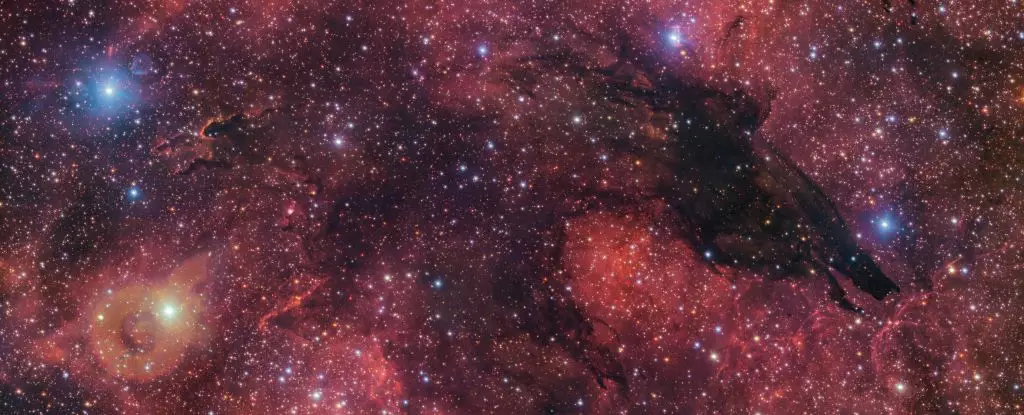In Norse mythology, Ragnarök signifies the twilight of the gods — a cataclysmic event that heralds the end of the world as we know it. Central to this tale is the legendary wolf Sköll, who is prophesied to consume the Sun in a celestial snare. This striking imagery of darkness overwhelming light serves as a potent symbol. Yet, in the great expanse of the cosmos, we encounter another ‘wolf’ — the Dark Wolf Nebula. Located 5,300 light-years from Earth, this nebula stands in counterpoint to Sköll’s destructive narrative, instead representing the cradle of new beginnings in the universe.
From a distance, the Dark Wolf Nebula may appear as a gaping abyss, a void where the light of distant stars seemingly vanishes. However, under the cloak of its shadows lies a bustling nursery for new stars. This nebula is a dense concentration of gas and dust, part of a larger structure known as Gum 55. Unlike bright nebulae that light up with celestial posturing, dark nebulae like this one absorb visible light, forcing astronomers to adopt different observational tactics.
The nebula’s dark appearance belies its bustling role; it facilitates the birth of stars through mechanisms governed by gravity and thermodynamics. Dense clumps of gas and dust gather in its depths, where temperature fluctuations cause them to coalesce. It is within these dark clouds that the seeds of future stars quietly accrete mass, ultimately igniting the violent and transformative reaction known as nuclear fusion.
Studying the intricate processes of star formation in such obscured environments presents numerous challenges. Traditional optical telescopes struggle to penetrate the thick screens of dust that envelop young stars, leaving astronomers in the dark — quite literally. However, advances in infrared astronomy have opened new corridors for exploration. Instruments like the James Webb Space Telescope (JWST) have become instrumental in observing thermal emissions that can travel through the dust, shedding light on the birth processes hidden within the nebula’s enigmatic fabric.
Infrared observations reveal patterns of motion and localized heating that accompany star formation events. Researchers can measure the distribution and behavior of gas and dust, crafting a more comprehensive picture of how stellar systems come into existence. This multi-wavelength approach underscores the need for an intricate understanding of cosmic structures. Visible-light observations, like those obtained from the VLT Survey Telescope, complement infrared data by revealing the surrounding environment, helping scientists decode the conditions necessary for the emergence of new stars.
The fascinating narrative of creation within the Dark Wolf Nebula resonates with the age-old cycle of life and death present throughout the universe. Much like Ragnarok’s celestial struggle between light and dark, the birth of stars elicits a dual dynamic. As newly-formed stars gather energy and start to shine, they eventually unleash powerful winds and radiation. This phase of their life cycles signifies a new chapter, often clearing out surrounding dust and gas clouds in a flurry of activity.
Thus, while dark clouds serve as stellar nurseries, the stars that emerge from them dramatically reshape their surroundings. This beautiful yet chaotic interplay emphasizes the transient nature of cosmic phenomena. Just as Sköll’s twilight is a harbinger of endings, the emergence of stars from the shadows of their nebulae bathes the universe in new light, heralding beginnings.
The Dark Wolf Nebula is emblematic of the grand cosmic dance where darkness gives birth to light. Its profound mystery reminds us that beneath apparent chaos lies the serenity of creation. As we explore the universe with advanced instruments, our understanding of these celestial phenomena expands, unveiling the intricacies of star formation. Such discoveries challenge us to reevaluate our perception of the cosmos and underline humanity’s perennial quest to uncover the mysteries of existence. The duality embodied in darkness and light encapsulates the very fabric of the universe — a continuous cycle of destruction and creation interwoven with the threads of celestial mythology.


Leave a Reply